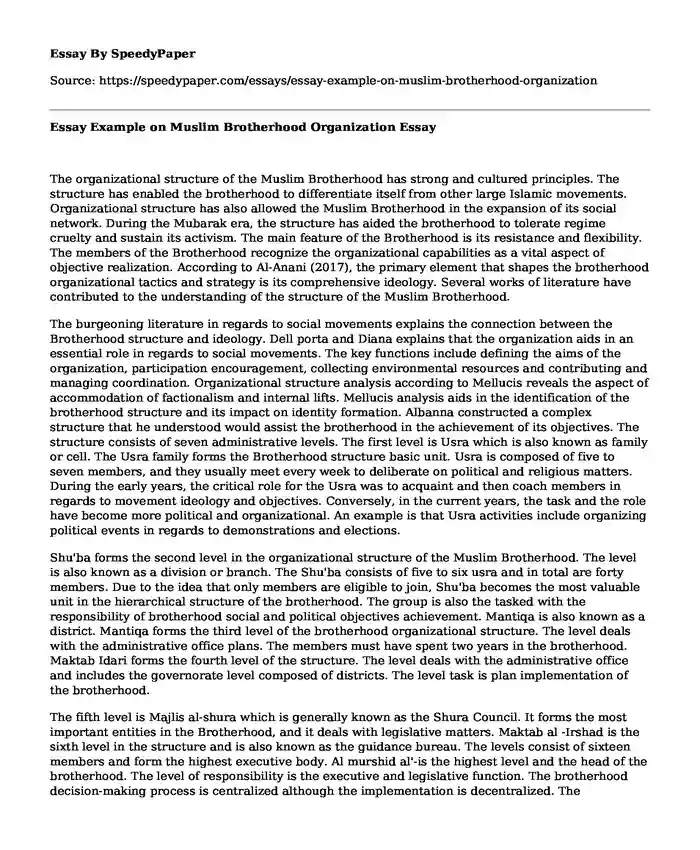
| Type of paper: | Essay |
| Categories: | Strategy Islam Organizational culture |
| Pages: | 3 |
| Wordcount: | 646 words |
The organizational structure of the Muslim Brotherhood has strong and cultured principles. The structure has enabled the brotherhood to differentiate itself from other large Islamic movements. Organizational structure has also allowed the Muslim Brotherhood in the expansion of its social network. During the Mubarak era, the structure has aided the brotherhood to tolerate regime cruelty and sustain its activism. The main feature of the Brotherhood is its resistance and flexibility. The members of the Brotherhood recognize the organizational capabilities as a vital aspect of objective realization. According to Al-Anani (2017), the primary element that shapes the brotherhood organizational tactics and strategy is its comprehensive ideology. Several works of literature have contributed to the understanding of the structure of the Muslim Brotherhood.
The burgeoning literature in regards to social movements explains the connection between the Brotherhood structure and ideology. Dell porta and Diana explains that the organization aids in an essential role in regards to social movements. The key functions include defining the aims of the organization, participation encouragement, collecting environmental resources and contributing and managing coordination. Organizational structure analysis according to Mellucis reveals the aspect of accommodation of factionalism and internal lifts. Mellucis analysis aids in the identification of the brotherhood structure and its impact on identity formation. Albanna constructed a complex structure that he understood would assist the brotherhood in the achievement of its objectives. The structure consists of seven administrative levels. The first level is Usra which is also known as family or cell. The Usra family forms the Brotherhood structure basic unit. Usra is composed of five to seven members, and they usually meet every week to deliberate on political and religious matters. During the early years, the critical role for the Usra was to acquaint and then coach members in regards to movement ideology and objectives. Conversely, in the current years, the task and the role have become more political and organizational. An example is that Usra activities include organizing political events in regards to demonstrations and elections.
Shu'ba forms the second level in the organizational structure of the Muslim Brotherhood. The level is also known as a division or branch. The Shu'ba consists of five to six usra and in total are forty members. Due to the idea that only members are eligible to join, Shu'ba becomes the most valuable unit in the hierarchical structure of the brotherhood. The group is also the tasked with the responsibility of brotherhood social and political objectives achievement. Mantiqa is also known as a district. Mantiqa forms the third level of the brotherhood organizational structure. The level deals with the administrative office plans. The members must have spent two years in the brotherhood. Maktab Idari forms the fourth level of the structure. The level deals with the administrative office and includes the governorate level composed of districts. The level task is plan implementation of the brotherhood.
The fifth level is Majlis al-shura which is generally known as the Shura Council. It forms the most important entities in the Brotherhood, and it deals with legislative matters. Maktab al -Irshad is the sixth level in the structure and is also known as the guidance bureau. The levels consist of sixteen members and form the highest executive body. Al murshid al'-is the highest level and the head of the brotherhood. The level of responsibility is the executive and legislative function. The brotherhood decision-making process is centralized although the implementation is decentralized. The bureaucratic movement exists in the organization due to the complexity of the structure. The Brotherhood also is subjected to power struggles just like any organization. The major critique if the structure is that it is male-dominated. The women representation lacks real authority or power. The Mubarak regime repressive policies towards the brotherhood aided it in internal unity, transparency, and openness.
References
Al-Anani, K. (2017). Inside the Muslim Brotherhood: Religion, identity, and politics. New York, NY: Oxford University Press.
Cite this page
Essay Example on Muslim Brotherhood Organization. (2022, Dec 21). Retrieved from https://speedypaper.net/essays/essay-example-on-muslim-brotherhood-organization
Request Removal
If you are the original author of this essay and no longer wish to have it published on the SpeedyPaper website, please click below to request its removal:
- Medicine Essay Example
- Free Essay Sample on the Madrars-Khanqah of Sultan Al-Ashraf Barsbay
- Essay Example: Aid Organization Report
- Abortion Pro-choice Essay Sample
- Essay Sample: Informed Consent for Research Data Collection
- Free Essay. Assessing and Treating Adult and Geriatric Clients With Mood Disorders
- Essay Sample: Hosseini's Narrative
Popular categories




